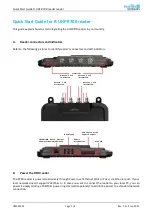
Fermenator G4 V2
© Blichmann Engineering, LLC 2021
For replacement parts, visit: blichmannengineering.com/genuine-replacement-parts
8
RACKING AND SERVING FINISHED BEER
Transferring beer out the G4 Fermenator can be done with either gravity or using CO2 pressure to transfer into a bottling bucket
or keg. To pressurize the fermentor, you can use either the Blichmann Tri-Clamp Spunding Valve or our 1-1/2” Tri-Clamp to Keg
post adaptor. Simply attach the device to the top port on the lid and pressurize the tank to the desired pressure. Do not attempt
to exceed 15 PSI.
The other method is gravity transfer. Simply elevate the vessel and drain into a keg or bottling bucket. Oxygen contact with the
beer is minimized by purging the vessel prior to transfer. Purge the keg with CO2 after transferring to eliminate any residual O2
in the headspace. Purge the keg prior to filling through the liquid out post to ensure all O2 is displaced from the bottom up as
CO2 is heavier than air. After filling, pressurize the keg through the CO2 post and pull the keg vent/PRV valve 4-5 times to ensure
all O2 has been removed form the head space.
WARNING: THE PRV IS NEVER TO BE USED AS A PRESSURE CONTROL FOR FERMENTATION!
RELEASE ALL PRESSURE AND REMOVE THE PRV FROM THE LID BEFORE REMOVING THE LID CLAMP!
EQUIPMENT REQUIRED:
SPUNDING VALVE TO REGULATE THE FERMENTATION PRESSURE AT THE DESIRED PRESSURE.
Pressure fermentation up to 15 PSI (1 BAR) is one of the key new features of the Fermenator G4 conical fermentor. Fermenting
under pressure suppresses the formation of esters by the yeast (fruity character) and allows the brewer to product lager-like
beer at room temperature, and in less time. In addition to ester reduction, diacetyl precursor production by the yeast is also
significantly reduced. Blichmann Engineering and White Labs have done extensive research on various pressures and the effect
on quantitative ester and diacetyl production. In addition, qualitative testing was done through National and Master ranked
BJCP judges. While pressure fermenting at higher pressure such at 30 PSI (2 BAR) does reduce esters even further, it also gives a
perceived thinner body, and also a harsher presentation of the hop bitterness. The panel found the traditional lager method to
produce the best overall flavor, but the 15 PSI at room temperature produced the best balance of ester reduction and hop flavor
quality. While esters are reduced, also is diacetyl. Not from the pressure, rather from the higher fermentation temperature. At
low levels that are appropriate for the style, diacetyl does add a perceived roundness to the malt character and the tasting panel
noted that this was missing from the pressure fermented beer. In summary, pressure fermentation produces a lager-like beer. Is
best done at approximately 15 PSI. But is not as rounded as a beer that is lagered in the traditional style.
TIP:
Do not use pressure fermentation when producing ales or you will not achieve the fruity character and balance necessary
in these styles. If you are unable to control temperatures of your ales to 66-72F, it may be necessary to apply 7-8 PSI to suppress
enough esters to achieve desired levels for the style. Experimentation with this is highly advised.
WARNING:
• Do not exceed 15 PSI
•
Do not remove the lid clamp before releasing all pressure and removing the PRV from the lid
• Do not tamper with or press on the PRV stem
• Do not leave the fermentor unattended during transferring
• Do not use loose whole hops, wood chips, or other similar material in the fermentor. Use a hop or grain bag to prevent loose
material from plugging the pressure relief valve or airlock causing a dangerous overpressure of the fermentor.
• Ensure that the surfaces of the pressure relief valve and seat are free from fermentables or other material prior to pressurization.
Clean as needed. Failure to do so may cause sticking and subsequent malfunction of the relief valve system.
WARNING:
Use a hop bag when using whole hops, wood chips, and other similar materials in the fermentor to prevent loose
material from plugging the pressure relief valve or airlock, which may cause a dangerous overpressure of the fermentor. In
addition, these materials will clog the racking tube making draining the finished beer/wine difficult. It is highly recommended
that you use a blow-off tube for primary fermentation! The optional tri-clamp blow-off assembly makes this very easy.
PRESSURE FERMENTATION





























